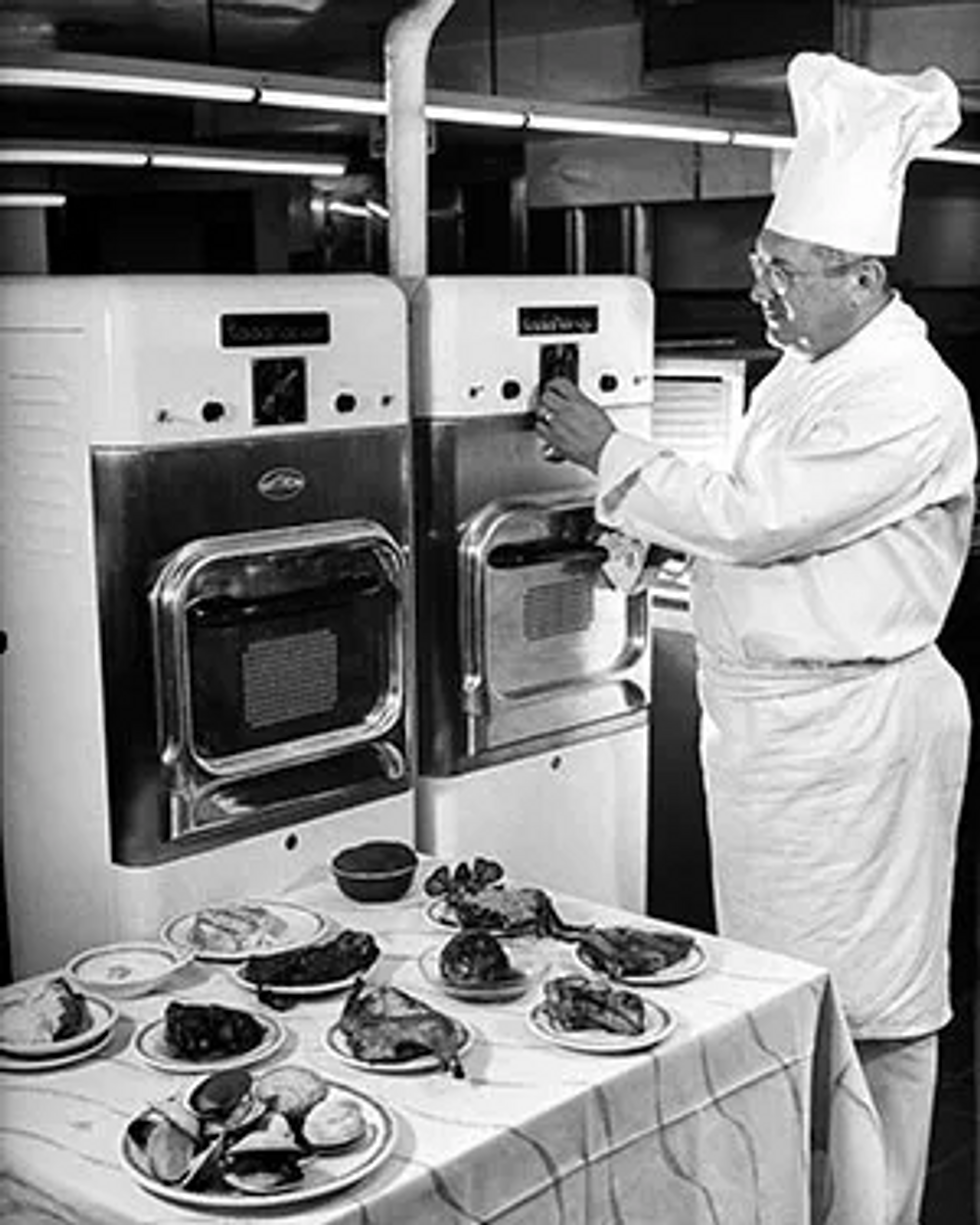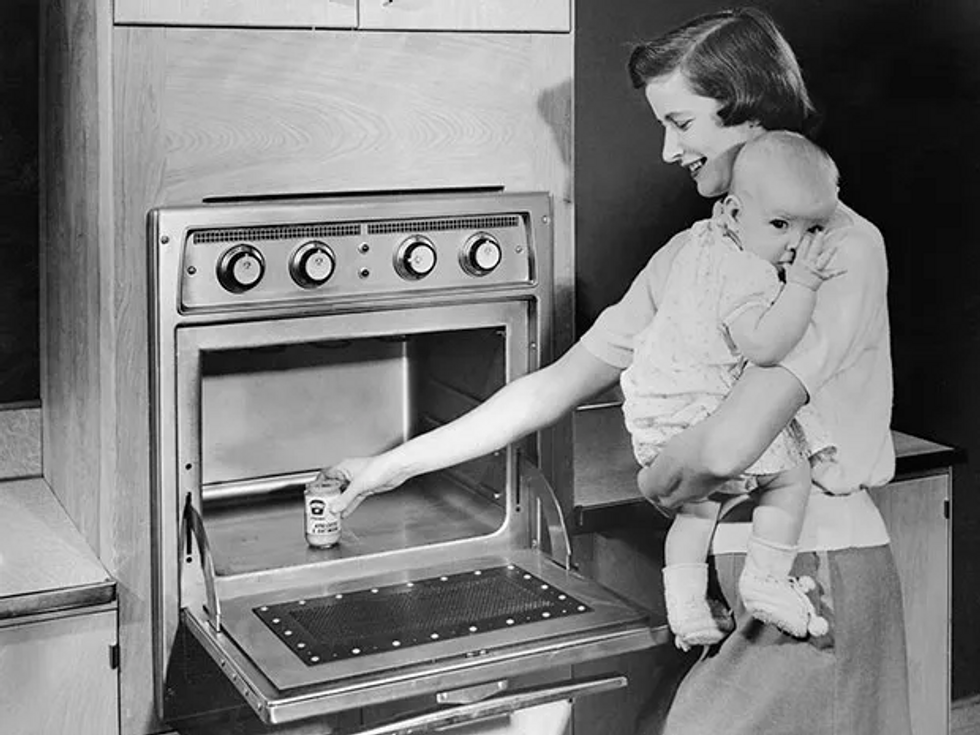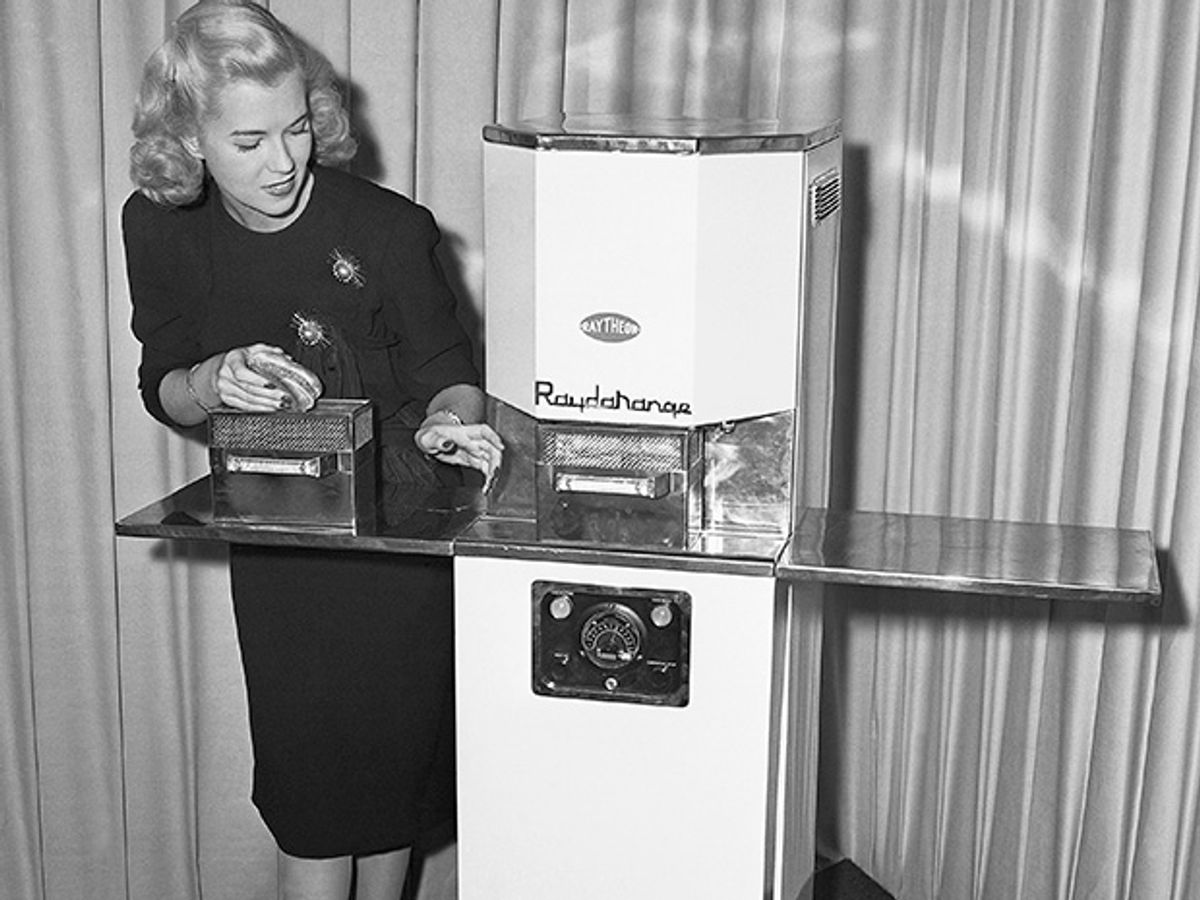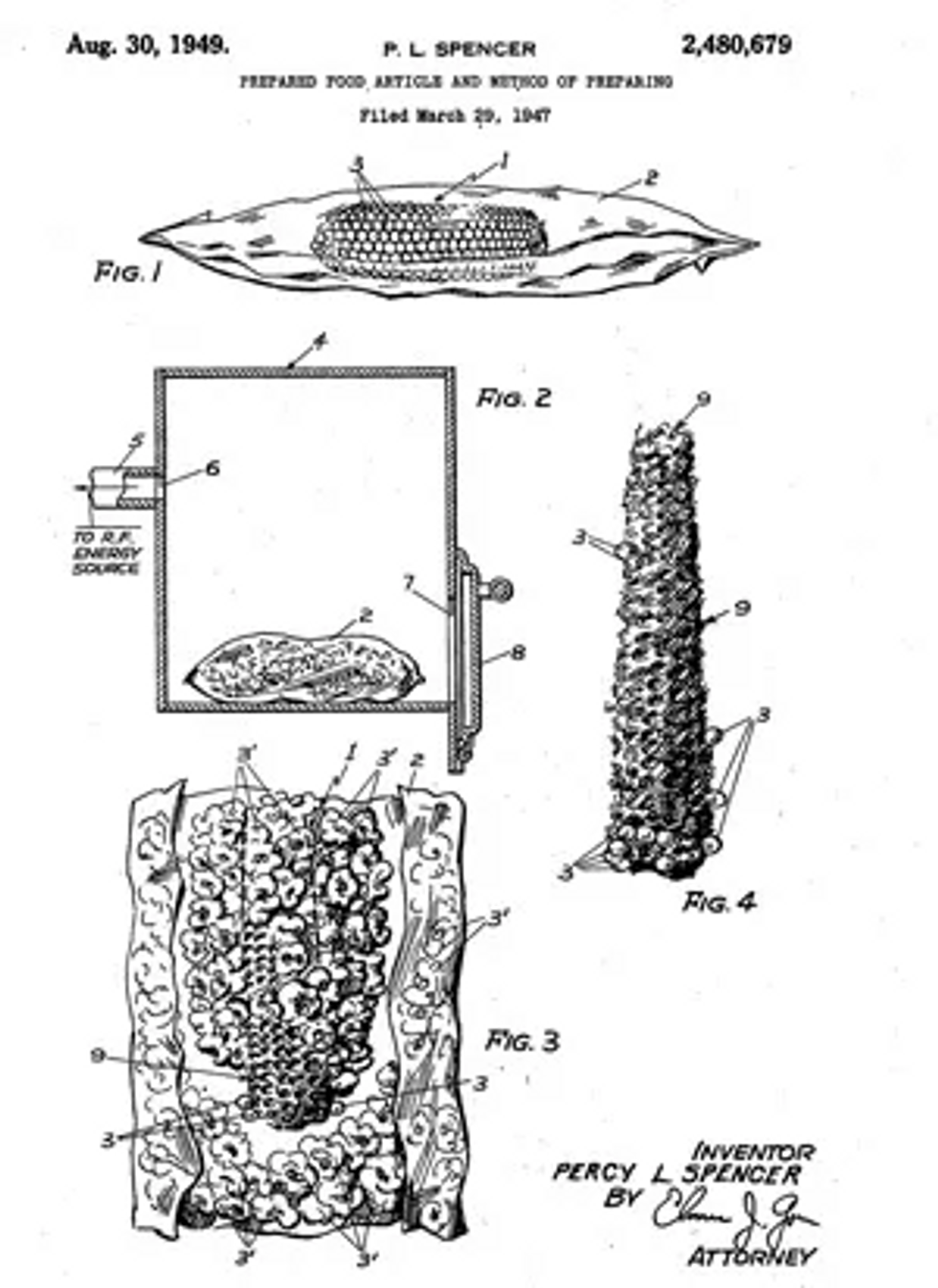UPDATE: 11 Jan. 2024: Since the following popular story on the 20th century history of the microwave was published in 2016, microwaves as a 21st century technology have been increasingly in the news—and not always for rapid preparation of foods for an overbusy restaurant kitchen or a harried Ozzie-and-Harriet-era housewife, as the story below details.
For one, Austrian scientists last year announced that zapping silicon solar cells in a microwave oven when they’ve reached the end of their useful life could actually enable rapid and easy recycling of these increasingly ubiquitous pieces of renewable electronics. Because microwaves selectively heat silicon in a wafer, glass and plastic and even aluminum pieces of the panel are unaffected. And the crucial components of a PV panel can then be readily recycled—as EU regulations now mandate. Likewise with a recent Japanese effort to recycle polyurethane foam with a microwave oven. The microwave oven’s selective heating effects can be used to help break down another set of non-edible items for eventual reuse.
But it’s not just for recycling that microwave heating shows newfound promise. South Korean scientists only last month unveiled a process that uses microwaves like the kind generated in the eponymous ovens for pest-control in soil samples. This would not be in a conventional oven-type arrangement, though. The team’s microwave technology instead resembles a big-agriculture-scale device that can process soil at the sample levels that can be meaningful to farmers. Meanwhile, Purdue scientists in August have developed technology to expedite vaccine preparation for freeze-drying and global distribution—while Penn State engineers unveiled in June a new tech to smelt metal on the moon using microwaves.
Microwaves in space and space-age technology are not of course terribly new. Cellphone networks use microwaves all the time. But higher and higher power levels of microwaves in aerospace settings also enable applications well beyond communication. In November, the U.S. Army was delivered their first high-power microwave beaming weapon to be potentially deployed against drones and even swarms of drones. While in June, Caltech scientists revealed how they could use microwave transmitters attached to vast, orbiting solar arrays, so the microwaves could then beam power back home for use on earth. Space-based solar power offers the attractive prospect of a 24/7, fully renewable power source that never sees nighttime or a cloudy day. And such baseload power would of course all the more enable the rapidly-developing rest of the world’s use of such conveniences of modern life as, just to pick an example out of the air, the microwave oven. —IEEE Spectrum
Original story from 30 Sept. 2016 follows:
As World War II came to an end, so did the market for the magnetron tubes that had been used to generate microwaves for short-range military radar. Magnetron makers like Raytheon eagerly sought new applications for the technology.
It was well known that radio waves would heat dielectric materials, and the use of dielectric heating in industrial and medical contexts was fairly common. The idea of heating food with radio waves wasn’t new either: Bell Labs, General Electric, and RCA had all been working on variations of the technology for some time. Indeed, at the 1933 World’s Fair in Chicago, Westinghouse demonstrated a 10-kilowatt shortwave radio transmitter that cooked steaks and potatoes between two metal plates. But nothing came of these culinary adventures.
Raytheon engineer Percy Spencer took it further. A 1958 article in Reader’s Digest described Spencer’s accidental discovery that microwaves could quickly heat food:
One day a dozen years ago [Spencer] was visiting a lab where magnetrons, the power tubes of radar sets, were being tested. Suddenly, he felt a peanut bar start to cook in his pocket. Other scientists had noticed this phenomenon, but Spencer itched to know more about it.
He sent a boy out for a package of popcorn. When he held it near a magnetron, popcorn exploded all over the lab. Next morning he brought in a kettle, cut a hole in the side and put an uncooked egg (in its shell) into the pot. Then he moved a magnetron against the hole and turned on the juice. A skeptical engineer peeked over the top of the pot just in time to catch a face-full of cooked egg. The reason? The yolk cooked faster than the outside, causing the egg to burst.

In 1946 Spencer filed for patents on the use of microwaves for cooking food. One of his patents even illustrated the popping of popcorn, cob and all.
And yet the Reader’s Digest claim that Spencer’s discovery led directly to the commercialization of the oven isn’t exactly supported by other accounts. In 1984, for example, Raytheon researcher John M. Osepchuk wrote about his and other colleagues’ recollections of that work in “A History of Microwave Heating Applications” [PDF, subscription required] for IEEE Transactions on Microwave Theory and Techniques:
Legends exist about a serendipitous discovery of microwave cooking by Percy Spencer… [Spence’s subordinates] all remember the discovery as a gradual process involving chance and deliberate observations by many individuals, e.g., feelings of warmth near radiating tubes, experimenting with pop corn, etc. Still, Percy Spencer was in a position to trigger the company into exploiting the discovery and his participation was a key contribution.
Despite the potential for near-instant snack food, the first commercial Radarange microwave ovens unveiled by Raytheon in 1946 were intended for use in restaurants (as in the photo at top, which shows a prototype called the “Raydarange”) and for reheating meals on airplanes. They were massive, expensive appliances built around 1.6-kW magnetron tubes that had to be continuously water cooled.
By 1955, Raytheon had begun licensing its microwave technology, and the first microwave oven designed for consumers went on sale from Tappan. The Tappan RL-1 was wall mounted and cost US $1,295 (almost $11,000 today), putting it out of the reach of most people.

Ten years later, Raytheon acquired Amana Refrigeration, and the first Amana Radaranges started showing up on household countertops in 1967 for a more affordable $495.
As microwaves became more common throughout the 1970s, concerns arose about the effects of microwave radiation on humans, as the New York Times described in 1974:
After testing 15 microwave ovens…Consumers Union warned in March, 1973, that none could be considered “completely safe,” in part because there was no solid data on safe levels of radiation emission.
Government and industry soon answered. [Food and Drug Administration] officials testified to the reliability of their standards before the Senate Commerce Committee’s radiation control hearings, while microwave oven makers proclaimed the safety of their products in publicity campaigns….
All this has not shaken the resolve of Consumers Union by one milliwatt. “We see no reason to change our minds, but we are always open to changing it when additional data comes in,” said Leonard Smiley, chief of the appliance division there….
For consumers, he said, the temporary solution to the complex problem is to beware the microwave oven.
Fortunately, here in the present, we have RF radiation safety figured out. Mostly.
This article appears in the October 2016 print issue as “When Nuking Food Was Novel.”
Part of a continuing series looking at old photographs that embrace the boundless potential of technology, with unintentionally hilarious effect.
- From World War II Radar to Microwave Popcorn, the Cavity Magnetron Was There - IEEE Spectrum ›
- Always Break Yolks: The Joy of Microwave Cooking - IEEE Spectrum ›
- The Rise and Fall of 3M’s Floppy Disk - IEEE Spectrum ›
- The First Automatic Rice Cooker’s Unlikely Inventor - IEEE Spectrum ›
- Electric Toy Stoves: A Hot History Lesson - IEEE Spectrum ›
Evan Ackerman is a senior editor at IEEE Spectrum. Since 2007, he has written over 6,000 articles on robotics and technology. He has a degree in Martian geology and is excellent at playing bagpipes.




